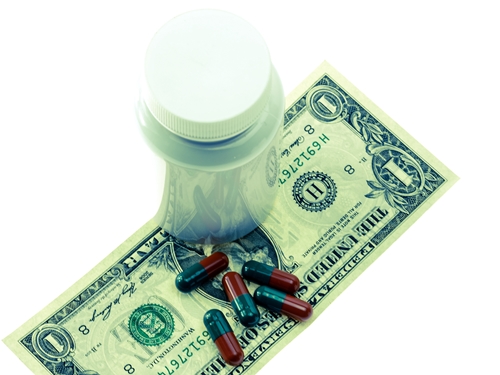10 June 2016. An evaluation of two new biologic drugs to treat diabetic macular edema, an eye disease caused by diabetes, show the drugs do not provide enough additional benefit over much less expensive treatments to justify their higher price tags. The team led by Adam Glassman of the Jaeb Center for Health Research in Tampa, Florida published its findings in yesterday’s issue of the journal JAMA Ophthalmology.
Glassman and colleagues from Northwestern, Michigan, and Johns Hopkins universities, sought to determine if the benefits for treating diabetic macular edema from the biologic drugs aflibercept and ranibizumab were substantial enough to justify their higher costs compared to bevacizumab. Diabetic macular edema is a complication of diabetes causing blurred vision and vision loss leading to blindness. It occurs when diabetes damages blood vessels in the eye, a condition known as diabetic retinopathy, resulting in leakage of blood and fluid, as well as swelling.
The treatments target production of vascular endothelial growth factor-A, or VEGF-A, a protein that stimulates growth of blood vessels, but excessive production of the protein is a key factor in diseases of the retina. Aflibercept is marketed by Regeneron as Eylea, approved by FDA for diabetic macular edema in March 2015, while ranibizumab is marketed by Genentech as Lucentis, and approved by FDA one month earlier. Bevacizumab, marketed by Genentech as Avastin, was first developed as a cancer drug, but is used off-label to treat eye disorders from diabetes, due in part to its much lower costs. All 3 drugs are given as injections in the eye once a month.
The team analyzed results of a late-stage clinical trial testing the 3 drugs with 624 individuals having diabetic macular edema. Participants were enrolled in the Diabetic Retinopathy Clinical Research Network, run by the Jaeb Center in Tampa. Results of the trial were first published in March 2015, showing the 3 drugs about equally as effective in improving the vision of individuals with diabetic macular edema, when the initial loss of visual acuity, or sharp vision, was mild — scores ranging from 20/32 to 20/40. When participants had more severe cases, however — scores of 20/50 or worse — aflibercept was shown to be more effective.
In the new study, the researchers re-examined the trial results but calculated quality of life improvements from the improved visual acuity for each month of the study. The team measured quality of life with a quality-adjusted life year, or QALY, index that runs from 0.0 (death) to 1.0 (excellent health). The QALY index considers the number of years of life, as well as factors such as mobility, pain, and ability to carry on usual activities. The researchers then computed incremental cost-effectiveness ratios that account for QALY index improvements for the 3 drugs.
The QALY indexes show participants receiving aflibercept had higher quality-of-life scores than recipients of bevacizumab, both for the sample overall and those starting out with mild cases of diabetic macular edema. The authors note that these results may seem at odds with the original trial that found aflibercept more effective with participants starting with worse visual acuity scores, but the QALY index considers more than visual acuity, thus not a direct relationship between the two measures.
When factoring in the differences in cost for the 3 drugs, a different picture emerges. The authors report the wholesale price in 2015 per dose for aflibercept was $1,850, while ranibizumab cost $1,170. Bevacizumab, on the other hand, when formulated for injections in the eye, cost $60 per dose. Most of the monthly treatments are given in the first year, with patients receiving 9 to 11 doses in that year. Over 5 years, patients receive on average 17 treatments.
In the first year, patients receiving bevacizumab (or their insurers) would expect to pay $4,100 for their medications, compared to $18,600 for ranibizumab and $26,100 for aflibercept. Over 10 years, individuals treated with bevacizumab would pay $39,800, compared to $79,400 for ranibizumab and $102,500 for aflibercept. Factoring in quality of life improvements over those 10 years, the incremental cost per QALY is $603,000 for ranibizumab and $349,000 for aflibercept.
The researchers conclude that the sharply higher costs for ranibizumab and aflibercept are not justified for diabetic macular edema, when compared to benefits achieved by the much lower-priced bevacizumab. The authors point out the higher costs for these drugs are already taking a sizeable toll on Medicare. They cite a 2012 report from the Inspector General at the Department of Health and Human Services showing Medicare paid $2 billion in 2010 for drugs targeting VEGF-A to treat eye diseases, about one-sixth the total budget for drugs under Medicare Part B given during office or outpatient visits. In addition, a Government Accountability Office report in October 2015 shows Medicare Part B in 2013 paid $2.5 billion alone for aflibercept and ranibizumab.
Read more:
- Another Chance to Get Serious on Drug Pricing
- Pricing Factors Proposed for Gene Therapies
- Drug Pricing Reform Even Big Pharma Might Like
- Many Clinical Trial Protocol Changes Avoidable, Costly
- Medical Industry Payment Recipients Identified
* * *


 RSS - Posts
RSS - Posts
You must be logged in to post a comment.